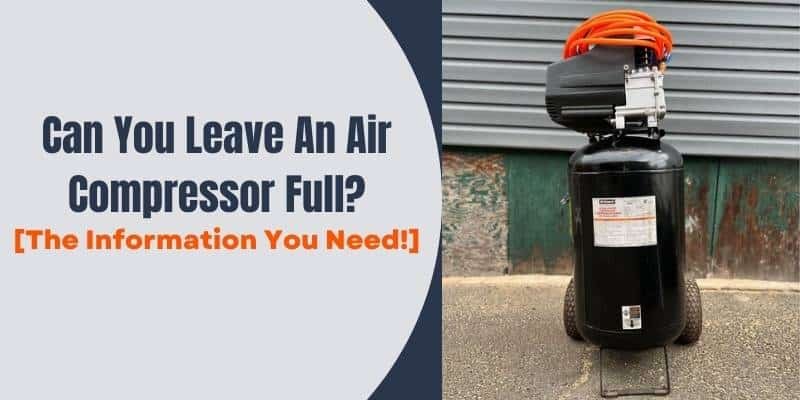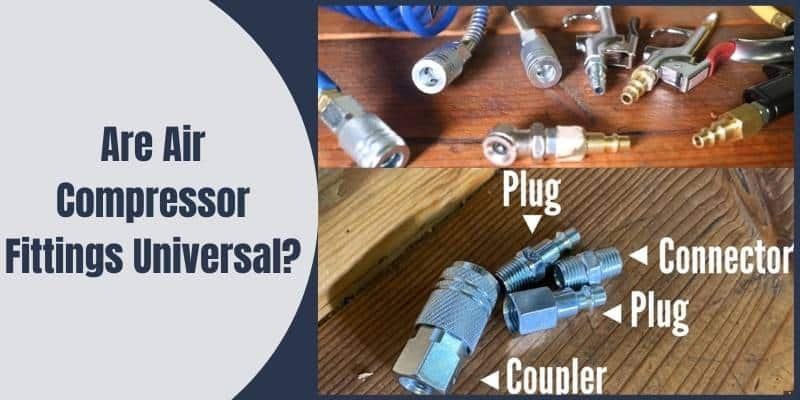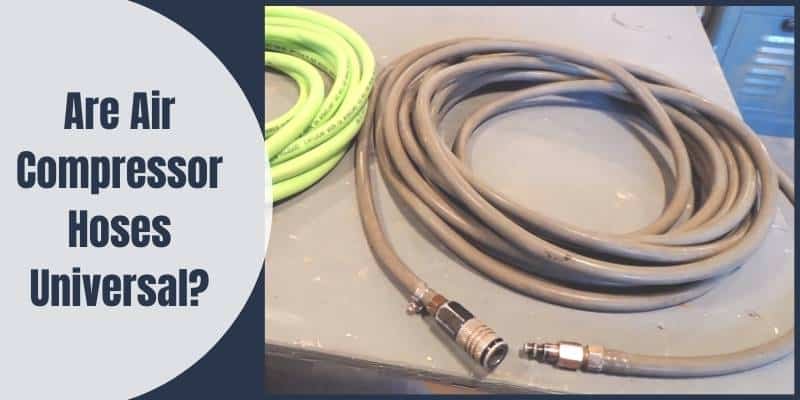Disclosure: This post contains affiliate links and I will be compensated if you make a purchase after clicking through my links. Learn More
Air compressors allow us to carry out numerous different activities both comfortably and easily, making them one of science’s greatest inventions. The speed and volume of compressed air vary depending on the type and capacity of the air compressor used. However, on average, it ranges from 100 to 175 PSI. This power represents an enormous amount of stored energy, ready to be used to power pneumatic tools and shop machinery.
When there’s so much compressed air under so much pressure, one question that keeps popping up is, “Can you leave an air compressor full?”
In this article, we will give a detailed answer to this question along with sharing information on when you should drain an air compressor, how you should drain it, and so on. Without further ado, let’s jump right in!

Can You Leave An Air Compressor Full?
Yes, You Can Leave an Air Compressor Full But There’s a Catch. Any quality air compressor can easily last fully pressurized for a couple of days without draining.
So, if you use your air compressor on a daily basis, leaving it full is perfectly fine. However, there is potential for disaster if you leave the air compressor full for days without noticing.
Catastrophes can begin with weakened seals and end with expensive repairs. To avoid these situations, you should always drain the air compressor regularly and deactivate it before putting it away for an extended period of time. It is the characteristics of compressed air that makes draining necessary and we’re going to explain this in a bit.
How long can you leave air in an air compressor?
You can safely leave air in an air compressor for a short period, such as overnight or up to a day or two. However, it’s not recommended to keep the compressor pressurized for an extended period due to potential issues.
Maintaining pressurized tanks can lead to decreased seal life and pose a safety risk. To mitigate these concerns, it’s advised to isolate and clearly mark the compressor as pressurized if you plan to leave air inside.
It’s essential to turn off the compressor when not in use to prevent unnecessary wear and tear on the system.
Compressed air might seem inexpensive as a power source, but unnoticed leaks can lead to the compressor pump running continuously to maintain tank pressure, resulting in increased energy consumption and potential equipment damage.
For a broader perspective, in industrial environments, compressors are kept pressurized 24/7 but are depressurized only for maintenance purposes.
In regular usage, it’s wise to strike a balance between convenience and system health by depressurizing the compressor when it’s not actively needed.
This approach can help extend the life of seals, ensure safety, and minimize energy waste, ultimately maximizing the efficiency and longevity of your air compressor system.
Top Reasons to Drain Your Air Compressor on a Regular Basis
Water vapor exists naturally in the air that surrounds us. Air compressors draw in and pressurize this ambient air to produce compressed air. As the air is compressed, water vapor is forced or condensed out of it.
The moisture begins to form and expand into larger droplets, similar to raindrops in a cloud, until falling to the lowest points in its restricted area, which is how water accumulates at the bottom of the compressor’s tank. If not drained on a regular basis, this water can harm the compressor, the tools you use with it, and the quality of the work performed.
To Prevent Corrosion in The Air Compressor Tank
Despite the fact that most manufacturers design the interior lining to repel rust, it cannot entirely prevent water from corroding the metal. Because air compressor tanks store highly pressurized air, you must do everything possible to keep them in good condition.
This includes eliminating moisture as early as you can. Other parts of the air compressor, such as pressure switches, safety release valves, and parts on the outlet side, also should be protected from prolonged contact with moisture.
To Protect The Tools And Compressor Parts
Water vapor from the pressurized air can run through the supply line on the outlet side of the equipment. Therefore, draining the tank will also shield any pneumatic tools and compressor parts that use compressed air at later stages from moisture. Air cylinders and valves are two equipment parts that are particularly susceptible to moisture.
To Increase The Quality of The Work
With moisture in the compressed air, the integrity of your woodworking would be seriously disturbed. Visual flaws can also appear during spray painting and airbrushing, and rust can develop from using it on metal workpieces.
The Frequency at Which You Drain an Air Compressor is Important
The frequency at which you should drain the compressor depends on its duty cycle and the humidity level in the environment. The greater the number of times your air compressor creates compressed air, the more waste water it will produce.
And draining will prevent this water from accumulating inside the tank, hence slowing down the corrosion process. This will eventually help prevent blowing up the air compressor and extend the life of your expensive machine.
Manufacturers often provide a maintenance schedule with most air compressors. Most of them recommend draining your tank several times per week when under regular duty cycle.
More specifically, you should empty the water from the tank at least once every couple of days for daily use. For light use such as impact wrench or nail guns, draining the tank once a week would be enough.
What if you use the air compressor occasionally? In such a case, it is strongly advised that you drain the compressor as soon as you have finished using it.
Electronic Drain Valves Can Automate the Draining Process
You may forget this, especially during the busy workshop days but it is really important to remember to drain your air compressor every so often, even if it isn’t used for extended periods of time.
That’s why most air compressors now come equipped with built-in electronic drain valves that can automatically monitor and start draining the water out of the tank if there is a preset period without usage. They may even offer several different options for scheduling the drainage intervals.
If the manufacturer does not include this at the time of purchase, you can buy them separately from the market. In addition, similar items such as drain extension kits are also available to help you automate draining air compressors off condensation.
You Can Manually Drain an Air Compressor in Four Steps
The nice thing about draining your air compressor manually is, it’s very easy.
Step 1: Turn off the Air Compressor
Before you begin draining the compressor tank, turn off the unit. This eliminates any potential hazards that could arise if you kept the unit engaged while releasing tank pressure. Set the power switch to “OFF” position and unplug or shut off the power source so that the unit is completely off.
Step 2: Reduce the Tank Pressure
Now you have to release the pressure inside the tank. To accomplish this, pull the metal ring located on the ASME safety valve. When performing this step, wear safety glasses because you are about to release highly pressurized air, which may cause dust or debris to shoot out of the opening.
You can use a rag to deflect the air and prevent debris from blowing at you while pulling the ring with the other hand. Pull the ring until the tank is completely empty.
Step 3: Locate and Release the Drain Valve
The drain valve is usually located at the bottom of the compressor tank. Before you release the valve make sure to place a tray so that the waste water doesn’t touch the floor. Now rotate the lever on the valve. You can use a wrench if it feels too tight to do it with the hand. As you release the valve the moisture from inside the tank will start to drain.
Step 4: Close the Drain Valve
Close the drain valve when all the water is removed from the tank. You can tilt the tank back and forth slightly if there is any trapped water inside. Make sure the drain valve is tight. Depending on whether you want to reuse the compressor right away or save it for another day, turn the unit on or leave it unpressurized.
Storing Your Air Compressor Properly is Vital
Properly storing an air compressor helps maintain and increase its lifespan. Here are some tips to do so correctly.
Firstly, keep your air compressor inside, in a dry and clean environment. This allows you to control variables such as temperature, moisture, and aeration. This will assist delaying things like corrosion, which can erode different parts of the air compressor over time.
However, places like basements and outdoor sheds are not ideal. Outdoor sheds tend to be less susceptible to flooding than basements, but they may not provide enough heat or moisture necessary to keep your air compressor in good working condition.
Secondly, you should find a raised platform to place your compressor. This aids in the prevention of groundwater damage.
Prepare your compressor for long term storage, when it will be out of use for an extended period of time. Allow the compressor to pressurize after you turn it off. When the regulator knob reaches zero, unplug the device from the wall. If it is battery operated, remove it and store it separately.
Check if you have disconnected all the connections. And the last thing you need to do is completely drain the tank. This will help you check for leaks and flaws in your compressor and make sure you have a properly running machine in the next use.
Final Words
Hopefully, by reading this article, you have gained enough knowledge regarding whether you can leave your air compressor full and under what circumstances.
If you know anyone who you think could find the information helpful, don’t hesitate to share the content. Also, we would love to hear your feedback about the post in the comment section below. Have a nice day!


